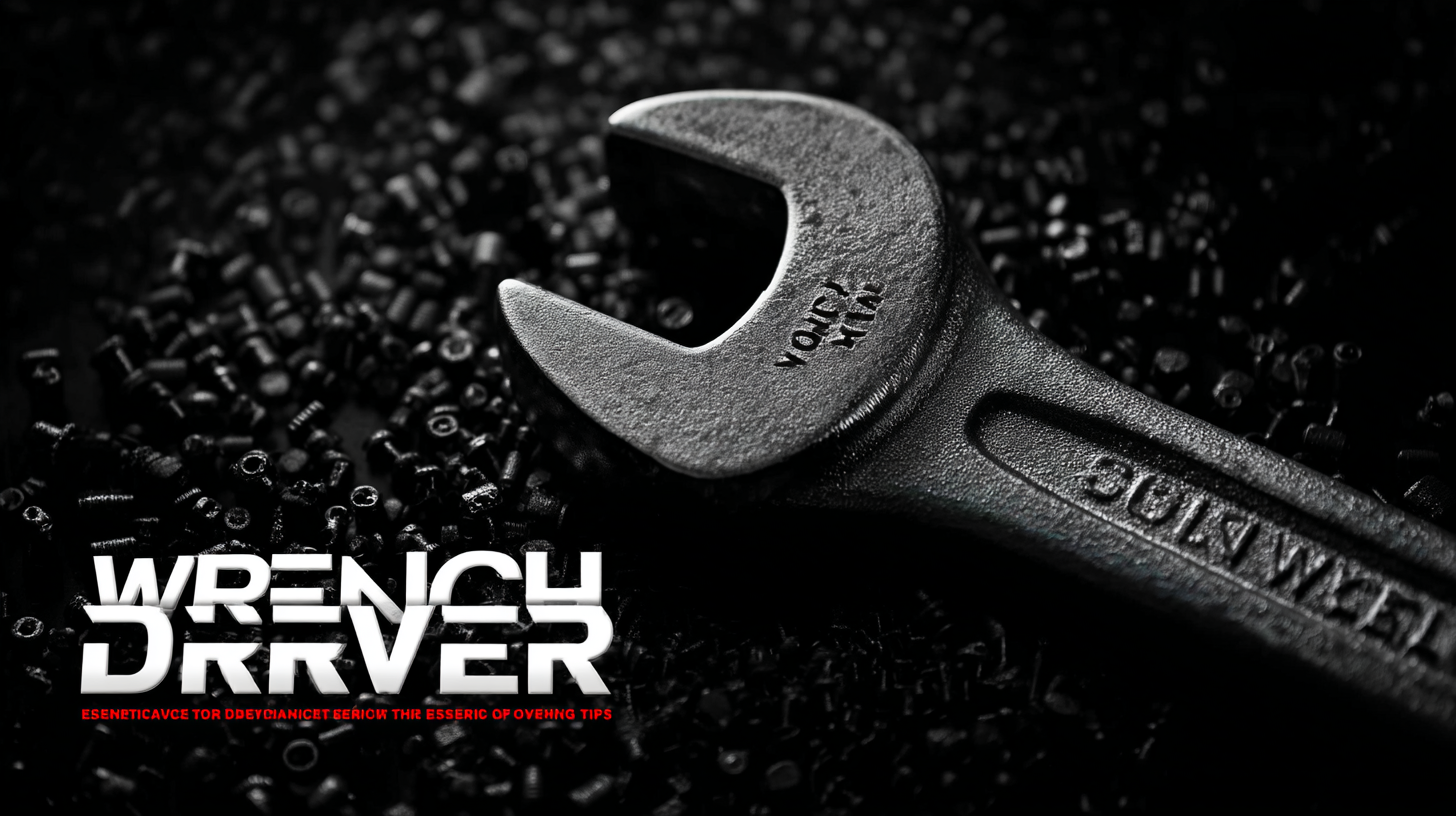
Understanding the Best Wrench Driver: Technical Specifications and Essential Usage Tips
In the world of mechanical tools, the Wrench Driver stands out as an indispensable device for both professionals and DIY enthusiasts alike. According to the recent report by the Global Hand Tools Market, the demand for wrench drivers has surged, with a projected growth rate of 5.2% CAGR through 2026. This increasing popularity is attributed to the tool's versatility and precision in fastening and loosening nuts and bolts across various applications, from automotive repair to construction. Understanding the technical specifications of different wrench drivers, such as torque settings, drive sizes, and material durability, is crucial for optimizing performance and ensuring safety. In this tutorial, we will delve into the essential aspects of selecting the best wrench driver, offering valuable insights and practical tips to enhance your tool selection and usage strategies.

The Importance of Choosing the Right Wrench Driver for Your Needs
Choosing the right wrench driver is crucial for achieving efficiency and precision in any mechanical task. According to a 2023 report by the National Institute for Occupational Safety and Health, improper tool selection can increase the risk of injury by up to 30%. Therefore, understanding the specific requirements of your project is essential for both safety and productivity. Whether you're a professional mechanic or a DIY enthusiast, the right wrench driver can significantly impact your work quality and outcomes.
Furthermore, selecting a wrench driver that aligns with the torque specifications of your job is vital. A study conducted by the American Society of Mechanical Engineers found that using tools that match recommended torque levels reduces the likelihood of fastener failure by 25%. This not only ensures the integrity of your project but also contributes to longer-lasting results. In light of these considerations, investing in a high-quality, appropriately-sized wrench driver tailored to your specific tasks can make a substantial difference, enhancing overall performance while minimizing risks.
Understanding the Best Wrench Driver: Technical Specifications and Essential Usage Tips
| Specification | Description | Usage Tips |
|---|---|---|
| Drive Size | Commonly available in 1/4", 3/8", and 1/2". Choose based on nut/bolt sizes. | Ensure the wrench driver matches the size of the fasteners you're working with. |
| Material | Typically made from chrome vanadium steel for durability and strength. | Look for corrosion-resistant finishes for better longevity. |
| Torque Range | Ranges typically from 10 to 300 ft-lbs; choose according to the application. | Use a torque wrench for precision; avoid over-tightening. |
| Grip Type | Ergonomic grips help reduce hand fatigue during use. | Choose a handle with a good grip to enhance control. |
| Weight | Lightweight drivers are easier to handle for extended periods. | Consider your work environment when choosing weight; heavier for rugged use, lighter for finesse. |
Key Technical Specifications to Consider When Selecting a Wrench Driver
When selecting a wrench driver, several key technical specifications should be considered to ensure optimal performance and usability. First, the torque range is crucial; it determines how much force the tool can apply. For most home projects, a torque range of 10-100 Nm is typically sufficient, while professional-grade wrench drivers can reach up to 500 Nm or more, catering to heavy-duty applications. Additionally, the drive size, often measured in inches, affects the compatibility with sockets and attachments. Common sizes include 1/4”, 3/8”, and 1/2”, which correspond to different torque and application needs.
Another important factor is the type of mechanism used in the wrench driver, such as click, beam, or digital mechanisms. Click-type wrench drivers are popular for their tactile feedback, indicating when the set torque has been reached. Digital wrenches, on the other hand, offer precision readings and often include features like memory settings for repetitive tasks, making them ideal for automotive applications. Reports indicate that digital torque wrenches can improve accuracy by up to 25% compared to traditional tools, significantly enhancing the user experience and reducing the risk of over-tightening. Thus, understanding these specifications will lead to a more informed choice and ultimately better results in your projects.
Understanding the Best Wrench Driver: Technical Specifications
Essential Usage Tips for Maximizing Wrench Driver Efficiency
To maximize the efficiency of a wrench driver, it’s crucial to focus on fundamental usage tips that can significantly enhance performance. First and foremost, understanding the torque settings is essential. According to a 2021 industry report by Torque Tools Group, using the correct torque setting can improve the performance of mechanical assemblies by up to 35%. When working on various fasteners, always calibrate your wrench driver to meet the manufacturer's specifications to prevent under-torquing or over-torquing, which can lead to equipment failure or damage.
Another critical usage tip involves the proper grip and technique. A study published by the Ergonomics Journal revealed that the correct hand positioning and grip strength reduce fatigue by 26% during extended usage periods, allowing for greater precision and control. Positioning the wrench driver so that your wrist remains straight, and using both hands when necessary not only enhances torque application but also minimizes the risk of injury. Regularly maintaining your tool, such as lubricating moving parts and checking for wear, ensures long-term reliability and functionality, ultimately contributing to smoother operation and efficiency in your projects.
Common Mistakes to Avoid When Using a Wrench Driver
When using a wrench driver, avoiding common mistakes can significantly enhance both the efficiency and safety of your tasks. One prevalent error is using the wrong size or type of wrench driver for a particular job. According to industry data, approximately 25% of mechanical failures are linked to improper tool selection. This not only jeopardizes the integrity of the task at hand but can also lead to equipment damage and increased repair costs. Always ensure that the wrench driver fits snugly on the fastener to avoid slipping, which can cause striping and other mechanical issues.

Another frequent mistake is applying excessive force during operation. Many users believe that more torque equates to better results, but this is a misconception. Research indicates that over-torquing can reduce the lifespan of both the tool and the fasteners, leading to premature wear or even breakage. It's essential to adhere to the manufacturer's torque specifications and use calibrated tools where possible. Furthermore, regular maintenance of your wrench driver is crucial; neglected tools can lead to inconsistencies and safety hazards, making it vital to keep them clean and well-lubricated for optimal performance.
Comparative Analysis of Different Types of Wrench Drivers and Their Benefits
When choosing the best wrench driver, it's essential to compare the various types available on the market.
 Socket wrenches, for example, are incredibly versatile and can handle a wide range of bolt sizes with their interchangeable sockets. This makes them ideal for both professional mechanics and DIY enthusiasts looking for a reliable tool. On the other hand, torque wrenches are specifically designed to apply a precise amount of torque, which is crucial for ensuring that fasteners are tightened correctly without the risk of damage.
Socket wrenches, for example, are incredibly versatile and can handle a wide range of bolt sizes with their interchangeable sockets. This makes them ideal for both professional mechanics and DIY enthusiasts looking for a reliable tool. On the other hand, torque wrenches are specifically designed to apply a precise amount of torque, which is crucial for ensuring that fasteners are tightened correctly without the risk of damage.
When utilizing these tools, it’s important to consider the specific application. For heavier-duty tasks, a ratchet wrench provides speed and convenience, allowing you to work quickly through multiple fasteners. However, for more delicate operations requiring precision, always opt for a torque wrench to prevent over-tightening.
Tips for effective usage include keeping your tools well-maintained and checking the calibration of your torque wrench regularly to ensure accuracy. Additionally, familiarize yourself with the recommended torque settings for various materials and components to avoid potential damage during assembly or repair. This comprehensive understanding will enable you to maximize the performance of your wrench drivers while safeguarding the integrity of your projects.
